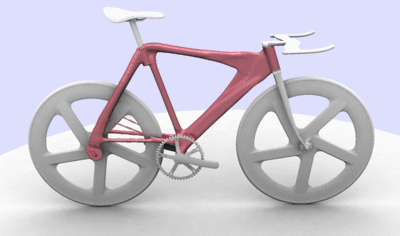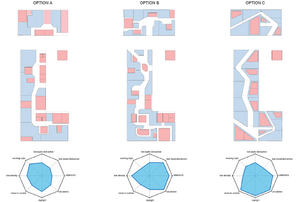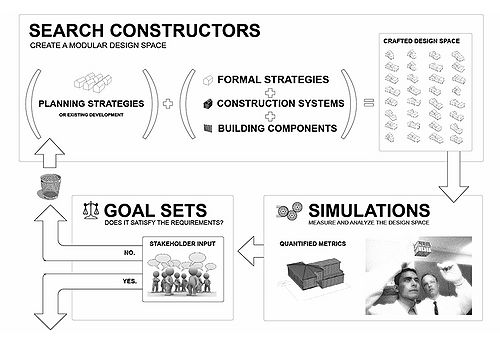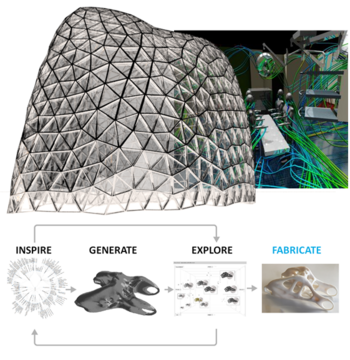The Future of Project Management with Generative Design

The digital technology has developed exponentially in the past few years and the construction industry has to understand the trends that comes with this development as some of the new technologies have come to disrupt the industry like the case with the transition from CAD to BIM. Some companies have been living after the principle "disrupt or die" in order to follow the demands and the competition from the market however overall, the construction industry is still lagging behind other industries when it comes to adopting new digital technologies [2]. McKinsey&Company has in a great report recently stated that one of the main subjects to focus on is to infuse digital technology and advanced automation. [3]
Generative design is a technology that has the purpose to mimic the natures evolutionary approach to design thus it is a radical new way of doing design propositions compared to the traditional way. Described shortly, the generative design concept is about expressing the design intent and purpose through e.g. planning strategies, formal strategies or building components, then get a computer to automatically explore all the options to improve e.g. materials, accuracy of cost and schedule estimates, manufacturing methods and risks thus streamlining the workflow of design, enabling more structured monitoring of projects and raise the transparency when the schedule is included. This allows the companies to explore a wider range of designs as based on criteria or rules and by this rethinking the design and engineering processes with e.g. a greater focus on constructability and productivity.
This article will mainly focus on the general aspects of generative design and how it possibly will disrupt the project management thus it will not focus on a specific tool, as the technology is progressing extremely rapidly. The potentials and the limitations with the new technology are also discussed with respect to project management.
Contents |
Design Technology Trends
Digitisation is a broad term that covers a variety of tools and technologies, including BIM (Building Information Modeling), automation, simulation and artificial intelligence and these new techonology trends open up new ways to work and collaborate. The digitalisation provides more productivity, deleveries of better products and of course a change in how people work. According to Winch is BIM a very important development in IT tools in the history of project management as it places the construction project manager as the key person in the project information flows. [4] In the following is BIM, computational design and generative design described shortly.
BIM
Building Information Modelling (BIM) is much more than a 3D-model. It is a technology-based collaboration process between technology and humans and also between humans thus it is a workflow and a process for creating and managing information on a construction project i.e. BIM is not a specific software tool but rather a way of working with 3D/4D models.
The BIM model contains a 3D model with information stored inside the objects. The difference between the old CAD systems and the new BIM systems is that the software can recognize objects as being walls, columns ect. and not just lines and this enables the computers to make calculations on the models, thus BIM information can be utilised to design with computational and generative design i.e. getting more and more automation.
Computational Design
Computational design is basically a design process expressed by using parameters and various rules that together define, decode and clarify the relationship between design intent and design output. For instance structural engineers use finite element analysis (FEA) and MEP engineers use computational fluid dynamics (CFD). With BIM models it is possible to make computations like these directly from the models if the information is sufficient.
| B (Building) |
I (Information) |
M (Model/Modeling) |
|
|
|
Table 1 shows some examples of how each letter in BIM can be interpreted when talking about computational design and generative design.
Generative Design
Generative Design is a programming-based approach where design intent and design purpose expressed, then a computer explores all the options of a solution to find the best solutions. It allows to * explore a wider range of design options as in the time a person can create one idea, a computer can generate thousands, along with the data to prove which designs that perform best based on the values and criterias that has been chosen.
Generative Design is about determining the values for a project, and the software will then create high-performing design options based on those criterias thus the software explores conflicting design constraints so the project team can focus on innovating instead. A design can be called generative when it is based on rules and criterias and these set of rules should fulfill the design should fulfill and the tool should come with multiple design solutions.
Application
Autodesk as a frontrunner in the Construction Industry

David Benjamin is founding principal of team The Living which is an Autodesk Studio and he has stated
"Generative design allows us to go beyond some of our typical human linear thinking, our typical rules of thumb – it basically allows us to discover new possibilities" [6]
Autodesk is a frontrunner in adapting generative design to the construction industry and has recently announced the newest software called Project Dreamcatcher. Dreamcatcher is a generative design system that enables designers to craft a definition of their design problem through goals and constraints. This information is used to synthesize alternative design solutions that meet the objectives. Designers are able to explore many alternative approaches and select design solutions for that fit their needs. The workflow is that the goals and constraints are iterated and adjusted to generate new results. The process generates thousands of options to choose from and each can be evaluated based on the goals.
Generative Design in Project Management

Today the construction industry is met with new requirements from the clients and this often happens when the client strives for innovation. With generative design the client, contractor, manufacturer and the stakeholders can be included in an integrated process as illustrated on Figure 4.
In reality, it's not about bits and bites, but about getting a better dialogue with the client, because with the digital tools it is possible to visualise and simulate solutions so that the client can see the solution before even getting started constructing the building. However digitization is not a solution in itself, but rather a supportive tool that will give clients an experience that they are invited in thus gaining a strong knowledge of many of the things they want, but can not always formulate. [8]
In the future, consultants will spend much more time working with customers on the creative part of the project development. Automation can not compete with the professionalism that engineers, architects and other professionals in the consulting industry contribute with. Engineers should therefore not worry, although increased automation will remove traditional computing tasks.
How will Generative Design affect the Project Management?
It may sound easy, but it is very challenging to define rules that make senses and will not produce just some garbages.
FROM A VALUE PERSPECTIVE VIEW
VALUE IS NOT JUST COSTS. UNDERSTANDING VALUE. CAN ANYONE ARGUE THAT SOMETHING IS MORE VALUEABLE THAN THE OTHER THING? IT DEPENDS ON THE CONTEXT. SHOULD THE VALUE BE BASED ON A GROUP CONSENT? OUR VALUE SHOULD BE BASED ON A VALID INFORMATION IN ORDER TO BE DURABLE. VALUE DISTRINT FROM QUALITY.
WHAT IS RELEVANT? ARE THE CLIENT AWARE OF WHAT HE CAN GET? OUR FRAMING AND PRIORITY OF DESIGN ELEMENTS ARE DIFFERENT. REFRAMING OF THE PROBLEM AND CONSIDER OTHER DESIGN SOLUTIONS
THE DESIGN PROCESS IS NEITHER LINEAR OR RATIONAL... PARTIES WORKING TOGETHER (PEOPLE WILL SIT WITH EACH OF THEIR SPECIALITY, BUT THEY DON'T UNDERSTAND THE WHOLE PICTURE) YOU WORK WITH THE DESIGN AND THEN GET A BETTER UNDERSTANDING OF THE PROBLEM AND THEN ITERATE TO GET THE BEST SOLUTION
SUPPORTING DECISION MAKING IN EARLY DESIGN. LET THE CLIENT TAKE PART IN THE DESIGN THUS GETTING A MORE ROBUST DESIGN. DESIGN MEETINGS. EXPLORE PRIORITIES (VALUE MANAGEMENT). AUDIT SOLUTIONS (ENGINEERING MANAGEMENT). DESIGN CRITERIA. CLIENTS DECISION MAKING
WHICH QUALITIES AND CRITERIAS DID I HAVE AT THE BEGINING? DEFINE YOUR RISK AGAINST YOUR BUSINESS CASE AND WHAT YOU WANT TO ACHIEVE. EVALUATE THE DESIGN. DOES THE VALUE SUDDENLY CHANGE? DESIGNER VALUES, CLIENT VALUES, PROJECT VALUES
The time used on detailed design becomes significantly shorter in the future. The first stages in which we are going to have the creative and where we are going in dialogue with the users will be significantly bigger. When you start up on detailed design and already have determined what to do, so it's only the features that need to be addressed and we will be much better in a future situation.
Discussion
There are two sides of these new disruptive technologies. One might say that the creative process, insight and wisdom is reserved for the engineers or designers and a computer should not take over this work. Another might say that the new technologies should be embraced so the computer could make the simple drawing and form creation thus instead focusing on and understanding the the real goals and constraints around the problem. A lot of the constraints does not lie as explicit knowledge thus it is important to figure out what the rules should be. However when the rules and goals have been identified, then the solutions should be picked and this can be difficult with thousands of solutions. The computers today have the processor force sort these solution by e.g. within the 10% best solutions and this is what the user then sees. Then it is up to the user to pick the solution that delivers the most important criteria.
Benefits
I think it will be one of the places where we will see who survives the competition and who does not survive the competition in the future. How fast can you do this detailed design? Because that's where there is a lot of time spent today. If we can halve this time then we have a huge competitive advantage.
We humans will be less in the business of forming or 3D modelling and more in the business of really understanding what are our requirements of the design. Understanding and managing these changes is vital, if we want to continue to provide solutions that truly meet the needs of our clients and stakeholders.
What is it that we want to get? What are our boundary conditions? Our operations assumptions? Which is kind of what humans are better at.
Limitations
There's a risk that designers will feel threatened by removing a large part of the creative process from their work – simply left to chose between a set of options each time.
"As companies redesign jobs and workforces, questions arise around the eventual limits of automation. Could essential human skills, such as empathy, communication, persuasion, personal service, problemsolving, and strategic decision-making become even more valuable? In moving towards greater automation, companies will have to rethink the role of people and provide training to prepare their employees for this new work environment. At Ford’s Cologne plant, robots and people are working side-by-side, complementing each other’s skills (simple and heavy vs creative). Businesses might soon start dividing skills and reframing jobs according to, on one hand, essential human skills and, on the other, nonessential tasks that could be carried out by machines"
Conclusion
It is difficult to define what can be done and what can not be done. About 50 years ago it was absurd if you were asked if you should know the exact location of 6 billion people, but today everyone walks around with a mobile phone with a GPS so it's possible to say where the 6 billion people are without asking each and every one. The same principle applies with generative design as with more and more computing power it is possible to calculate 10,000 possible solution e.g. to find out which pipeline is best. The processor power is not the challenge anymore but rather a question of how well the construction industry is willing to implement it. The next step in the digitalisation is to apply artificial intelligense which will soon be a game changer in the IT tools for design.
Further Reading
Annotated Bibliography
| Author | Title | Date | Language | Category | Brief description | Link | Visited |
|---|---|---|---|---|---|---|---|
| Jonny Williamson | How does generative design unlock engineering innovation? | 2017 | English | Webpage | Comes in a later version | https://www.themanufacturer.com/articles/how-does-generative-design-unlock-engineering-innovation/ | 11-06-2017 |
| Autodesk | The Future of Making Things: Generative Design | 2017 | English | Webpage | Comes in a later version | http://www.kb-eye.com/video/autodesk-cto-jeff-kowalski-discusses-possibilities-future-generative-design/ | 12-06-2017 |
| Rafael Sacks, Paul Teicholz, Chuck Eastman & Kathleen Liston | BIM Handbook - A Guide to Building Information Modeling for Owners, Managers, Designers, Engineers and Contractors | 2011 | English | Book | Comes in a later version |
Links to other wiki-articles (will be integrated in the text as links in a later version)
References
- ↑ Autodesk (2017). https://autodeskresearch.com/projects/dreamcatcher. (10-06-2017)
- ↑ Rob Leslie-Carter, John McGlynn, and Andrew Edkins (2017). Future of project management. Arup and The Bartlett Faculty of the Built Environment at UCL and Association for Project Management 1, 21–24.
- ↑ McKinsey&Company (2017). Reinventing construction: A route to higher productivity. McKinsey Global Insitute 1, 8–10.
- ↑ Winch, G. (2010). Managing Construction Projects. Wiley-Blackwell 2, 396.
- ↑ Vermeulen, D. (2017).Generative Design Applied on Buildings. http://autodesk.typepad.com/bimtoolbox/2017/06/generative-design-applied-on-buildings.html. (11-06-2017)
- ↑ Autodesk Toronto (2017). http://autodesktoronto.com/generative-design/. (10-06-2017)
- ↑ Architectureresearchlab (2012). http://www.architectureresearchlab.com/arl/wp-content/uploads/2012/08/search-construct.jpg. (10-06-2017)
- ↑ Wessel, L. (2017). Digitalisering giver plads til ingeniørens kreative sider. https://ing-dk.cdn.ampproject.org/c/s/ing.dk/artikel/digitalisering-giverplads-ingeniorens-kreative-sider-200009?amp. (11-06-2017)
